基因毒性杂质的评估与控制
ichm7基因毒性杂质评估和控制◆中英
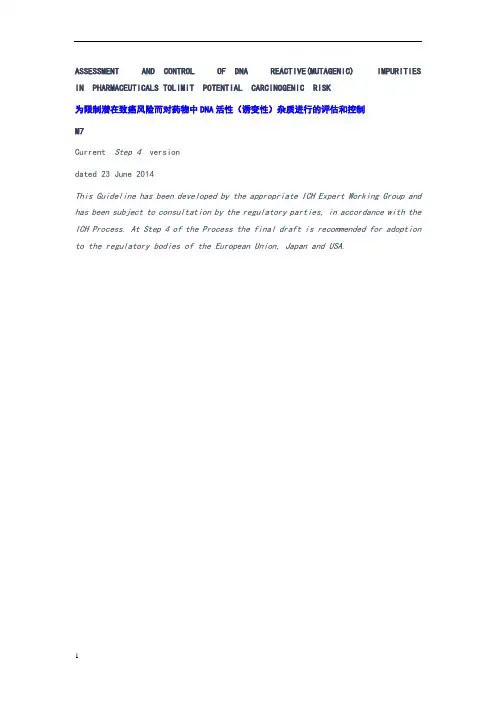
ASSESSMENT AND CONTROL OF DNA REACTIVE(MUTAGENIC) IMPURITIES IN PHARMACEUTICALS TOLIMIT POTENTIAL CARCINOGENIC RISK为限制潜在致癌风险而对药物中DNA活性(诱变性)杂质进行的评估和控制M7Current Step 4 versiondated 23 June 2014This Guideline has been developed by the appropriate ICH Expert Working Group and has been subject to consultation by the regulatory parties, in accordance with the ICH Process. At Step 4 of the Process the final draft is recommended for adoption to the regulatory bodies of the European Union, Japan and USA.M7Document History 文件历史Current Step 4 version 现行版本第4阶段Legal Notice: This document is protected by copyright and may be used, reproduced, incorporated into other works, adapted, modified, translated or distributed under a public license provided that ICH's copyright in the document is acknowledged at all times. In case of any adaption, modification or translation of the document, reasonable steps must be taken to clearly label, demarcate or otherwise identify that changes were made to or based on the original document. Any impression that the adaption, modification or translation of the original document is endorsed or sponsored by the ICH must be avoided.The document is provided "as is" without warranty of any kind. In no event shall the ICH or the authors of the original document be liable for any claim, damages or other liability arising from the use of the document.The above-mentioned permissions do not apply to content supplied by third parties. Therefore, for documents where the copyright vests in a third party, permission for reproduction must be obtained from this copyright holder.ASSESSMENT AND CONTROL OF DNA REACTIVE (MUTAGENIC) IMPURITIES IN PHARMACEUTICALS TO LIMIT POTENTIALCARCINOGENIC RISK为限制潜在致癌风险而对药物中DNA活性(诱变性)杂质进行的评估和控制ICH Harmonised Tripartite GuidelineICH三方协调指南Having reached Step 4 of the ICH Process at the ICH Steering Committee meeting on 5 June 2014, this Guideline is recommended for adoption to the three regulatory parties to ICHASSESSMENT AND CONTROL OF DNA REACTIVE (MUTAGENIC) IMPURITIES IN PHARMACEUTICALS TO LIMIT POTENTIALCARCINOGENIC RISK为限制潜在致癌风险而对药物中DNA活性(诱变性)杂质进行的评估和控制1. INTRODUCTION概述The synthesis of drug substances involves the use of reactive chemicals, reagents, solvents, catalysts, and other processing aids. As a result of chemical synthesis or subsequent degradation, impurities reside in all drug substances and associated drug products. While ICH Q3A(R2): Impurities in New Drug Substances and Q3B(R2): Impurities in New Drug Products (Ref. 1, 2) provides guidance for qualification and control for the majority of the impurities, limited guidance is provided for those impurities that are DNA reactive. The purpose of this guideline is to provide a practical framework that is applicable to the identification, categorization, qualification, and control of these mutagenic impurities to limit potential carcinogenic risk. This guideline is intended to complement ICH Q3A(R2), Q3B(R2) (Note 1), and ICH M3(R2): Nonclinical Safety Studies for the Conduct of Human Clinical Trials and Marketing Authorizations for Pharmaceuticals (Ref. 3).原料药合成牵涉到使用活性化学物质、试剂、溶剂、催化剂和其它工艺助剂,导致在所有原料药及其制剂中会残留有化学合成或其降解产物、杂质。
【医药】如何控制基因毒性杂质
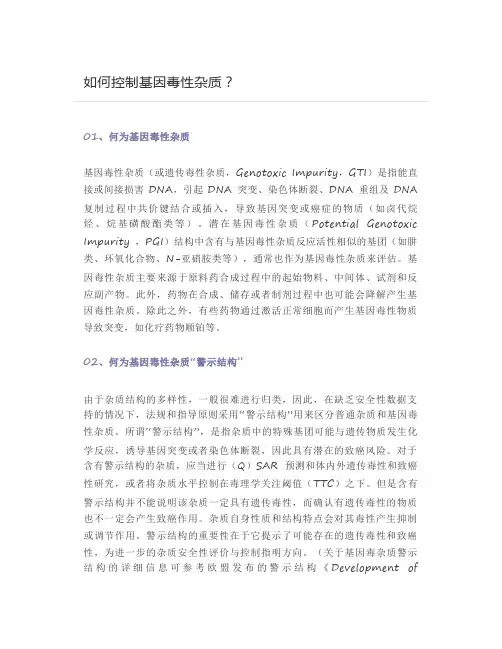
01、何为基因毒性杂质基因毒性杂质(或遗传毒性杂质,Genotoxic Impurity,GTI)是指能直接或间接损害DNA,引起DNA突变、染色体断裂、DNA重组及DNA 复制过程中共价键结合或插入,导致基因突变或癌症的物质(如卤代烷烃、烷基磺酸酯类等)。
潜在基因毒性杂质(Potential Genotoxic Impurity ,PGI)结构中含有与基因毒性杂质反应活性相似的基团(如肼类、环氧化合物、N-亚硝胺类等),通常也作为基因毒性杂质来评估。
基因毒性杂质主要来源于原料药合成过程中的起始物料、中间体、试剂和反应副产物。
此外,药物在合成、储存或者制剂过程中也可能会降解产生基因毒性杂质。
除此之外,有些药物通过激活正常细胞而产生基因毒性物质导致突变,如化疗药物顺铂等。
02、何为基因毒性杂质“警示结构”由于杂质结构的多样性,一般很难进行归类,因此,在缺乏安全性数据支持的情况下,法规和指导原则采用“警示结构”用来区分普通杂质和基因毒性杂质。
所谓“警示结构”,是指杂质中的特殊基团可能与遗传物质发生化学反应,诱导基因突变或者染色体断裂,因此具有潜在的致癌风险。
对于含有警示结构的杂质,应当进行(Q)SAR预测和体内外遗传毒性和致癌性研究,或者将杂质水平控制在毒理学关注阈值(TTC)之下。
但是含有警示结构并不能说明该杂质一定具有遗传毒性,而确认有遗传毒性的物质也不一定会产生致癌作用。
杂质自身性质和结构特点会对其毒性产生抑制或调节作用。
警示结构的重要性在于它提示了可能存在的遗传毒性和致癌性,为进一步的杂质安全性评价与控制指明方向。
(关于基因毒杂质警示结构的详细信息可参考欧盟发布的警示结构《Development ofstructure alerts for the in vivo micronucleus assay in rodents》)。
03、基因毒性杂质严格控制的必要性基因毒性杂质最主要的特点是在极低浓度时即可造成人体遗传物质的损伤,导致基因突变并促使肿瘤发生。
基因毒性杂质的评估与控制

6. Istituto Superiore di Sanita (Italy) 7. Prous Institute (Spain) 8. Swedish Toxicology Science Research Center(Sweden)
1.临床使用剂量增加 2.用药时长显著增加 3.病情严重或危及生命的病患状态下采用较高可接 受摄入量,变为不那么严重的病患情况后,原有的 杂质可接受摄入量不再适当 4.使用新的给药途径 5.扩大使用患者群包括孕妇和(或)小儿
◆新的杂质被确知属于第一类或第二类诱变性杂
质
THREE
基因毒性杂质的评估
一、评估内容
五、杂质残留风险评估考量
基毒杂质清除因子计算表
代码
GTI
到API 步骤
3 2 1
反应活 性
1-100 X X
溶解性
1-10(100) X X
挥发性
1-10 X X
电离性
5 X X
消除因 子/步
XXX
总消除因 子
清除 原理
Xx,xxx,xxx
参考文献: Teasdale A, Elder D, Chang S-J, et al. Risk assessment of genotoxic impurities in new chemical entities: strategies to demonstrate control[J]. Org Process Res Dev, 2013, 17: 221-230.
FDA
2008 年签发《原料药和成品药中遗传 毒性和致癌性杂质,推荐方法》
内容和EMA指南基本一致,主要包括: ◆ 原料药和制剂中的基因毒性杂质生 成的预防办法
ICH M7step4基因毒性杂质评估和控制◆中英
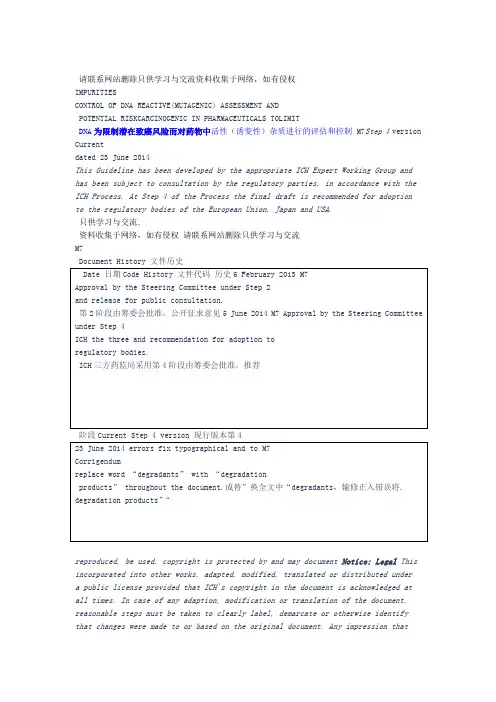
请联系网站删除只供学习与交流资料收集于网络,如有侵权IMPURITIESCONTROL OF DNA REACTIVE(MUTAGENIC) ASSESSMENT ANDPOTENTIAL RISKCARCINOGENIC IN PHARMACEUTICALS TOLIMITDNA为限制潜在致癌风险而对药物中活性(诱变性)杂质进行的评估和控制 M7Step 4 version Currentdated 23 June 2014This Guideline has been developed by the appropriate ICH Expert Working Group and has been subject to consultation by the regulatory parties, in accordance with the ICH Process. At Step 4 of the Process the final draft is recommended for adoption to the regulatory bodies of the European Union, Japan and USA.只供学习与交流.资料收集于网络,如有侵权请联系网站删除只供学习与交流M7Document History 文件历史阶段Current Step 4 version 现行版本第4reproduced, be used, copyright is protected by and may document Notice: Legal This incorporated into other works, adapted, modified, translated or distributed under a public license provided that ICH's copyright in the document is acknowledged at all times. In case of any adaption, modification or translation of the document, reasonable steps must be taken to clearly label, demarcate or otherwise identify that changes were made to or based on the original document. Any impression thatthe adaption, modification or translation of the original document is endorsed or sponsored by the ICH must be avoided.只供学习与交流.请联系网站删除只供学习与交流资料收集于网络,如有侵权The document is provided as is without warranty of any kind. In no event shallthe ICH or the authors of the original document be liable for any claim, damagesor other liability arising from the use of the document.parties. third content supplied by apply above-mentioned The permissions do not to for party, permission third in copyright where for Therefore, documents the vests a reproduction must be obtained from this copyright holder.只供学习与交流.请联系网站删除只供学习与交流资料收集于网络,如有侵权IMPURITIES(MUTAGENIC) OF DNA REACTIVE ASSESSMENT AND CONTROLRISKLIMIT IN PHARMACEUTICALS TO POTENTIALCARCINOGENIC活性(诱变性)杂质进行的评估和控制为限制潜在致癌风险而对药物中DNA ICH Harmonised Tripartite Guideline 三方协调指南ICH Step 4 of the ICH Process at the ICH Steering Committee meeting Having reachedregulatory three on 5 June 2014, this Guideline is recommended for adoption to the parties to ICH资料收集于网络,如有侵权请联系网站删除只供学习与交流只供学习与交流.资料收集于网络,如有侵权请联系网站删除只供学习与交流IMPURITIESDNA REACTIVE (MUTAGENIC) ASSESSMENT AND CONTROL OFRISKPHARMACEUTICALS TO LIMIT POTENTIALCARCINOGENIC IN活性(诱变性)杂质进行的评估和控制为限制潜在致癌风险而对药物中DNA概述1. INTRODUCTIONreagents, chemicals, of reactive drug substances involves the use of The synthesis solvents, catalysts, and other processing aids. As a result of chemical synthesis associated and drug substances degradation, impurities reside in all or subsequent drug products. While ICH Q3A(R2): Impurities in New Drug Substances and Q3B(R2): and for qualification guidance (Ref. 1, 2) provides Impurities in New Drug Products those provided for impurities, limited guidance is control for the majority of the impurities that are DNA reactive. The purpose of this guideline is to provide a categorization, the identification, is applicable to practical framework that potential limit mutagenic these impurities to qualification, and control of carcinogenic risk. This guideline is intended to complement ICH Q3A(R2), Q3B(R2) (Note 1), and ICH M3(R2): Nonclinical Safety Studies for the Conduct of HumanClinical Trials and Marketing Authorizations for Pharmaceuticals (Ref. 3).导致在所有原催化剂和其它工艺助剂,原料药合成牵涉到使用活性化学物质、试剂、溶剂、新原料药中的杂质Q3A(R2)料药及其制剂中会残留有化学合成或其降解产物、杂质。
基因毒性杂质研究方案
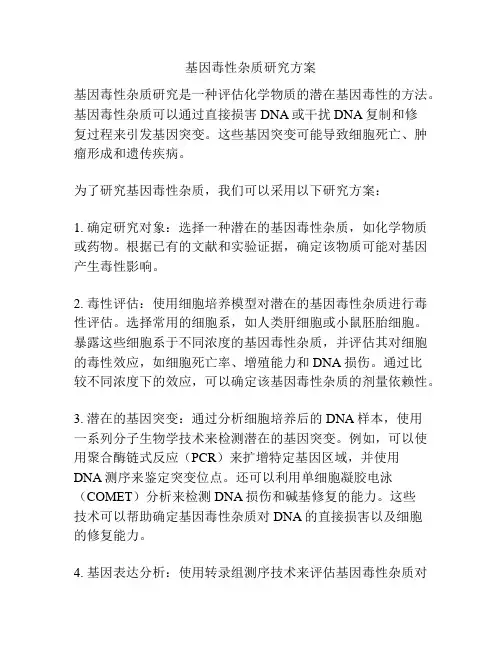
基因毒性杂质研究方案基因毒性杂质研究是一种评估化学物质的潜在基因毒性的方法。
基因毒性杂质可以通过直接损害DNA或干扰DNA复制和修复过程来引发基因突变。
这些基因突变可能导致细胞死亡、肿瘤形成和遗传疾病。
为了研究基因毒性杂质,我们可以采用以下研究方案:1. 确定研究对象:选择一种潜在的基因毒性杂质,如化学物质或药物。
根据已有的文献和实验证据,确定该物质可能对基因产生毒性影响。
2. 毒性评估:使用细胞培养模型对潜在的基因毒性杂质进行毒性评估。
选择常用的细胞系,如人类肝细胞或小鼠胚胎细胞。
暴露这些细胞系于不同浓度的基因毒性杂质,并评估其对细胞的毒性效应,如细胞死亡率、增殖能力和DNA损伤。
通过比较不同浓度下的效应,可以确定该基因毒性杂质的剂量依赖性。
3. 潜在的基因突变:通过分析细胞培养后的DNA样本,使用一系列分子生物学技术来检测潜在的基因突变。
例如,可以使用聚合酶链式反应(PCR)来扩增特定基因区域,并使用DNA测序来鉴定突变位点。
还可以利用单细胞凝胶电泳(COMET)分析来检测DNA损伤和碱基修复的能力。
这些技术可以帮助确定基因毒性杂质对DNA的直接损害以及细胞的修复能力。
4. 基因表达分析:使用转录组测序技术来评估基因毒性杂质对基因表达的影响。
通过比较暴露于基因毒性杂质的细胞和未暴露的对照细胞,可以鉴定潜在的差异表达基因。
这些差异表达基因可能与基因毒性杂质相关的毒性途径和生物学效应有关。
5. 分析结果的解释:根据实验数据,进行数据统计和生物信息学分析,以解释实验结果。
这可能涉及到寻找共同受影响的信号通路、寻找注释基因和分析基因表达调控网络。
通过以上研究方案,我们可以全面地评估基因毒性杂质的作用机制和潜在的风险。
这些研究结果可以为药物开发和环境毒理学领域提供重要的参考,帮助保护人类和环境健康。
ICHM7(step4)基因毒性杂质评估和控制◆中英
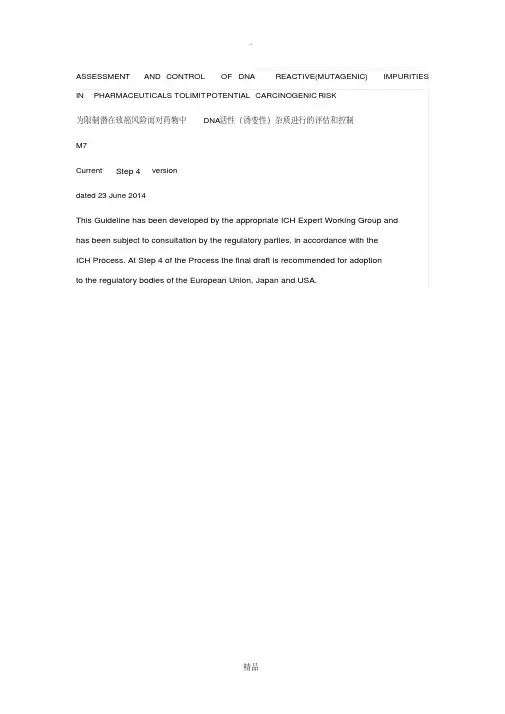
ASSESSMENT AND CONTROL OF DNA REACTIVE(MUTAGENIC) IMPURITIES IN PHARMACEUTICALS TOLIMIT P OTENTIAL CARCINOGENIC RISK为限制潜在致癌风险而对药物中DNA活性(诱变性)杂质进行的评估和控制M7Current Step 4 versiondated 23 June 2014This Guideline has been developed by the appropriate ICH Expert Working Group andhas been subject to consultation by the regulatory parties, in accordance with theICH Process. At Step 4 of the Process the final draft is recommended for adoptionto the regulatory bodies of the European Union, Japan and USA.M7Document History 文件历史Code 文件代码History 历史Date 日期6 February 2013 M7 Approval by the Steering Committee under Step 2and release for public consultation.第2阶段由筹委会批准,公开征求意见5 June 2014M7 Approval by the Steering Committee under Step 4and recommendation for adoption to the three ICHregulatory bodies.第4阶段由筹委会批准,推荐ICH三方药监局采用Current Step 4 version 现行版本第4阶段23 June 2014M7 Corrigendum to fix typographical errors andreplace word “degradants” with “degradationproducts” throughout the document.修正输入错误,将全文中“degradants”替换成“degradation products”.Legal Notice: This document is protected by copyright and may b e used, reproduced, incorporated into other works, adapted, modified, translated or distributed undera public license provided that ICH's copyright in the document is acknowledged atall times. In case of any adaption, modification or translation of the document,reasonable steps must be taken to clearly label, demarcate or otherwise identifythat changes were made to or based on the original document. Any impression thatthe adaption, modification or translation of the original document is endorsed orsponsored by the ICH must be avoided.The document is provided "as is" without warranty of any kind. In no event shallthe ICH or the authors of the original document be liable for any claim, damagesor other liability arising from the use of the document.The above-mentioned permissions do not apply to content supplied by third parties. Therefore, for documents where the copyright vests in a third party, permission for reproduction must be obtained from this copyright holder.ASSESSMENT AND CONTROL OF DNA REACTIVE (MUTAGENIC) IMPURITIES IN PHARMACEUTICALS TO LIMIT POTENTIALCARCINOGENIC RISK为限制潜在致癌风险而对药物中DNA活性(诱变性)杂质进行的评估和控制ICH Harmonised Tripartite GuidelineICH三方协调指南Having reached Step 4 of the ICH Process at the ICH Steering Committee meetingon 5 June 2014, this Guideline is recommended for adoption to the three regulatory parties to ICHTABLE OF CONTENTS目录1. INTRODUCTION概述2. SCOPE OF GUIDELINE指南范围3. GENERAL PRINCIPLES通用原则4. CONSIDERATIONS FOR MARKETED PRODUCTS上市产品应考虑的问题批准后原料药化学、生产和质量变更4.1 Post-Approval Changes to the DrugSubstance Chemistry, Manufacturing, andControls4.2 Post-Approval Changes to the Drug批准后制剂的化学、生产和质量变更Product Chemistry, Manufacturing, andControls上市产品临床使用变更4.3 Changes to the Clinical Use ofMarketed Products4.4 Other Considerations for Marketed上市产品其它应考虑问题Products原料药和制剂杂质评估5. DRUG SUBSTANCE A ND DRUG PRODUCTIMPURITY ASSESSMENT5.1 Synthetic Impurities 合成杂质5.2 Degradation Products 降解产物5.3 Considerations for ClinicalDevelopment临床研发要考虑的问题6. HAZARD ASSESSMENT ELEMENTS危害性评估要素7. RISK CHARACTERIZATION风险特征7.1 TTC-based Acceptable Intakes 根据TTC制订可接受摄入量7.2 Acceptable Intakes Based on Compound-Specific Risk Assessments 根据化合物特定风险评估制订的可接受摄入量7.2.1 Mutagenic Impurities with Positive Carcinogenicity Data (Class 1 in Table 1)致癌数据有利的诱变性杂质(表1中的第1类)7.2.2 Mutagenic Impurities with Evidencefor a Practical Threshold具有实用阈值证据的诱变性杂质7.3 Acceptable Intakes in Relation to LTLExposure与LTL暴露相关的可接受摄入量7.3.1 Clinical Development临床研发7.3.2 Marketed Products已上市产品7.4 Acceptable Intakes for MultipleMutagenic Impurities多个诱变性杂质的可接受摄入量7.5 Exceptions and Flexibility inApproaches方法例外情况和弹性8. CONTROL控制8.1 Control of Process Related Impurities 工艺相关杂质的控制8.2 Considerations for Control Approaches 控制方法要考虑的问题8.3 Considerations for Periodic Testing定期检查要考虑的问题8.4 Control of Degradation Products降解产物的控制8.5 Lifecycle Management生命周期管理临床研发要考虑的问题8.6 Considerations for ClinicalDevelopment9. DOCUMENTATION文件记录9.1 Clinical Trial Applications临床试验应用9.2 Common Technical Document (Marketing通用技术文件(上市申报)Application)NOTES注解GLOSSARY术语REFERENCES参考文献APPENDICES附录ASSESSMENT AND CONTROL OF DNA REACTIVE (MUTAGENIC) IMPURITIES IN PHARMACEUTICALS TO LIMIT POTENTIALCARCINOGENIC RISK为限制潜在致癌风险而对药物中DNA活性(诱变性)杂质进行的评估和控制1. INTRODUCTION概述The synthesis of drug substances involves the use of reactive chemicals, reagents, solvents, catalysts, and other processing aids. As a result of chemical synthesisor subsequent degradation, impurities reside in all drug substances and associated drug products. While ICH Q3A(R2): Impurities in New Drug Substances and Q3B(R2):Impurities in New D rug Products (Ref. 1, 2) provides guidance for qualification and control for the majority of the impurities, limited guidance is provided for those impurities that are DNA reactive. The purpose of this guideline is to provide apractical framework that is applicable to the identification, categorization, qualification, and control of these mutagenic impurities to limit potential carcinogenic risk. This guideline is intended to complement ICH Q3A(R2), Q3B(R2)(Note 1), and ICH M3(R2): Nonclinical Safety Studies for the Conduct of HumanClinical Trials and Marketing Authorizations for Pharmaceuticals (Ref. 3).原料药合成牵涉到使用活性化学物质、试剂、溶剂、催化剂和其它工艺助剂,导致在所有原料药及其制剂中会残留有化学合成或其降解产物、杂质。
ICH M7(step4)基因毒性杂质评估和控制◆中英剖析
ASSESSMENT AND CONTROL OF DNA REACTIVE(MUTAGENIC) IMPURITIES IN PHARMACEUTICALS TOLIMIT POTENTIAL CARCINOGENIC RISK为限制潜在致癌风险而对药物中DNA活性(诱变性)杂质进行的评估和控制M7Current Step 4 versiondated 23 June 2014This Guideline has been developed by the appropriate ICH Expert Working Group and has been subject to consultation by the regulatory parties, in accordance with the ICH Process. At Step 4 of the Process the final draft is recommended for adoption to the regulatory bodies of the European Union, Japan and USA.M7Document History 文件历史The document is provided "as is" without warranty of any kind. In no event shall the ICH or the authors of the original document be liable for any claim, damages or other liability arising from the use of the document.The above-mentioned permissions do not apply to content supplied by third parties. Therefore, for documents where the copyright vests in a third party, permission for reproduction must be obtained from this copyright holder.ASSESSMENT AND CONTROL OF DNA REACTIVE (MUTAGENIC) IMPURITIES IN PHARMACEUTICALS TO LIMIT POTENTIALCARCINOGENIC RISK为限制潜在致癌风险而对药物中DNA活性(诱变性)杂质进行的评估和控制ICH Harmonised Tripartite GuidelineICH三方协调指南Having reached Step 4 of the ICH Process at the ICH Steering Committee meeting on 5 June 2014, this Guideline is recommended for adoption to the three regulatory parties to ICHASSESSMENT AND CONTROL OF DNA REACTIVE (MUTAGENIC) IMPURITIES IN PHARMACEUTICALS TO LIMIT POTENTIALCARCINOGENIC RISK为限制潜在致癌风险而对药物中DNA活性(诱变性)杂质进行的评估和控制1. INTRODUCTION概述The synthesis of drug substances involves the use of reactive chemicals, reagents, solvents, catalysts, and other processing aids. As a result of chemical synthesis or subsequent degradation, impurities reside in all drug substances and associated drug products. While ICH Q3A(R2): Impurities in New Drug Substances and Q3B(R2): Impurities in New Drug Products (Ref. 1, 2) provides guidance for qualification and control for the majority of the impurities, limited guidance is provided for those impurities that are DNA reactive. The purpose of this guideline is to provide a practical framework that is applicable to the identification, categorization, qualification, and control of these mutagenic impurities to limit potential carcinogenic risk. This guideline is intended to complement ICH Q3A(R2), Q3B(R2) (Note 1), and ICH M3(R2): Nonclinical Safety Studies for the Conduct of Human Clinical Trials and Marketing Authorizations for Pharmaceuticals (Ref. 3).原料药合成牵涉到使用活性化学物质、试剂、溶剂、催化剂和其它工艺助剂,导致在所有原料药及其制剂中会残留有化学合成或其降解产物、杂质。
(完整版)基因毒性杂质的评估与控制
杂质 来源
降解杂质
加速试验、长期试验、光降 解、强制降解试验
环境污染
三、基因毒性杂质识别
工艺杂质
实际杂质
潜在杂质
API中实际观察到>ICH Q3A 报告限(0.05%)工艺杂质
1)合成API过程:起始物料,中间体,化学试剂 2)风险评估可能带入API中的,存在于起始物料,中间体中已识别 的杂质,以及合理机理预测产生的副产物(对于工艺早期杂质携带 入API的风险可忽略,但要提供基于风险论证的表明哪步后应该评估 杂质的潜在突变性) 3)对后工艺引入的起始物料,评价起始物料合成最后一步的潜在基 因毒性杂质
2018年
华海药业生产的缬沙坦原料药中含有微量基因毒性杂质N,N-二甲 基亚硝胺(NDMA),缬沙坦及其相关制剂从欧洲、美国和中国市 场被召回。
2018年
印度Torrent制药生产的缬沙坦片剂中也检测出含有NDMA,该公司 也从美国市场上自愿召回了14批相关药品。
二、相关概念
何为基因毒性杂质?
基因毒性杂质,也称遗传毒性杂质,通常指较低水平可直接造成DNA损伤,进而导致DNA突变, 因此可能引发癌症的DNA反应性物质。
EMA
2006年颁布《基因毒性杂质限度指南》
2010年发布《遗传毒性杂质限度指导 原则问答》 ◆为限制新活性物质中的基因毒性杂 质提供了解决问题的框架和具体方案。
◆新药必须进行基因毒性杂质分析
◆对于现有药品,不强制进行基因毒 性杂质分析评估
◆对已上市产品进行化学合成变更或 仿制药上市前,需对合成路线、过程 控制、杂质概括评价并与现有产品对 比,以确定未引入新的或更高水平的 基因毒性杂质
降解杂质
长 期 稳 定 性 试 验 , API 中 观 察 到>ICH Q3A报告限降解产物
ICHM7(step4)基因毒性杂质评估和控制◆中英
ASSESSMENT AND CONTROL OF DNA REACTIVE(MUTAGENIC) IMPURITIES IN PHARMACEUTICALS TOLIMIT POTENTIAL CARCINOGENIC RISK为限制潜在致癌风险而对药物中DNA活性(诱变性)杂质进行的评估和控制M7Current Step 4 versiondated 23 June 2014This Guideline has been developed by the appropriate ICH Expert Working Group and has been subject to consultation by the regulatory parties, in accordance with the ICH Process. At Step 4 of the Process the final draft is recommended for adoption to the regulatory bodies of the European Union, Japan and USA.M7Document History 文件历史The document is provided "as is" without warranty of any kind. In no event shall the ICH or the authors of the original document be liable for any claim, damages or other liability arising from the use of the document.The above-mentioned permissions do not apply to content supplied by third parties. Therefore, for documents where the copyright vests in a third party, permission for reproduction must be obtained from this copyright holder.ASSESSMENT AND CONTROL OF DNA REACTIVE (MUTAGENIC) IMPURITIES IN PHARMACEUTICALS TO LIMIT POTENTIALCARCINOGENIC RISK为限制潜在致癌风险而对药物中DNA活性(诱变性)杂质进行的评估和控制ICH Harmonised Tripartite GuidelineICH三方协调指南Having reached Step 4 of the ICH Process at the ICH Steering Committee meeting on 5 June 2014, this Guideline is recommended for adoption to the three regulatory parties to ICHASSESSMENT AND CONTROL OF DNA REACTIVE (MUTAGENIC) IMPURITIES IN PHARMACEUTICALS TO LIMIT POTENTIALCARCINOGENIC RISK为限制潜在致癌风险而对药物中DNA活性(诱变性)杂质进行的评估和控制1. INTRODUCTION概述The synthesis of drug substances involves the use of reactive chemicals, reagents, solvents, catalysts, and other processing aids. As a result of chemical synthesis or subsequent degradation, impurities reside in all drug substances and associated drug products. While ICH Q3A(R2): Impurities in New Drug Substances and Q3B(R2): Impurities in New Drug Products (Ref. 1, 2) provides guidance for qualification and control for the majority of the impurities, limited guidance is provided for those impurities that are DNA reactive. The purpose of this guideline is to provide a practical framework that is applicable to the identification, categorization, qualification, and control of these mutagenic impurities to limit potential carcinogenic risk. This guideline is intended to complement ICH Q3A(R2), Q3B(R2) (Note 1), and ICH M3(R2): Nonclinical Safety Studies for the Conduct of Human Clinical Trials and Marketing Authorizations for Pharmaceuticals (Ref. 3).原料药合成牵涉到使用活性化学物质、试剂、溶剂、催化剂和其它工艺助剂,导致在所有原料药及其制剂中会残留有化学合成或其降解产物、杂质。
基因杂质的评估和控制 ICH M7
(细菌诱变呈阳性*,无啮齿动物 TTC)
rodents》。或进入 The Carcinogenic Potency
致癌数据
Database (CPDB),里面有 1547 种致癌物质的列
3
警示结构,与原料药结构无关,无 控制不高于可接受限度(适当的
诱变数据
TTC)或检测细菌诱变含量:
表,结构式,CAS 号,作用部位,TTC 值等一系
基因杂质的评估和控制 ICH M7
1 概述
1 概述
ICH Q3A(R2) 新原料药中的杂质 ICH Q3B(R2) 新制剂中的杂质
关于主要杂质定性和控制的指南
ICH M3(R2) 药物人用临床试验和上市许可中的非临床安全性研究
EMA《遗传毒性杂质限度指导原则》
ICH M7 为限制潜在致癌风险而对药物中DNA活性(诱变性)杂质进行的评估和控制 目的:提供使用框架,以应用于这些诱变杂质的鉴别、分类、定性和控制,对潜在致癌风险进行了控制。 强调:在建立诱变性杂质水平时考虑安全性和质量风险管理两方面 人用条件下,给出对原料药或制剂中残留或可能残留的诱变性杂质评估和控制的建议
➢ 如果有足够后续试验,可由单独的体外试验结果,可以对它的体内关联性进行评估。
➢ 若缺乏这些信息时,体外基因毒性物质经常被考虑为假定的体内诱变剂和致癌剂。
----摘自EMA《毒性杂质限度
指南》
✓ 为何重点研究基因毒性杂质? 基毒杂质特点:很低浓度时即可造成人体遗传物质的损伤,进而导致基因突变并可能促使肿瘤发生。
补充
1 概述
✓ 何为基因毒性杂质、诱变杂质(Genotoxic Impurities,Mutagenic Impurities)?
基因毒性杂质(或遗传毒性杂质,Genotoxic Impurity ,GTI)是指化合物本身直接或间接损伤细胞DNA,产生基因突变或体内
- 1、下载文档前请自行甄别文档内容的完整性,平台不提供额外的编辑、内容补充、找答案等附加服务。
- 2、"仅部分预览"的文档,不可在线预览部分如存在完整性等问题,可反馈申请退款(可完整预览的文档不适用该条件!)。
- 3、如文档侵犯您的权益,请联系客服反馈,我们会尽快为您处理(人工客服工作时间:9:00-18:30)。
精品课件
一、法规速览
EMA率先开始关注基因 毒性杂质(磺酸酯类
化合物)。
EMA发布《基因毒性 杂质限度指南》 (草案),首次提 出毒理学关注阈值 (TTC)限度。
FDA发布《原料药和成 品药中遗传毒性和致 癌性杂质推荐方法》 CHMP安全工作 组发布 Q&A,提出决策树。
CFDA 修 订 《 药 物 遗 传毒性研究技术指 导原则》用于指导 和规范药物遗传毒 性研究。
精品课件
上市后药品临床使用变更
◆已上市药品临床应用变更拒收情节包括:重新评 估诱变杂质限度时 1.临床使用剂量增加 2.用药时长显著增加 3.病情严重或危及生命的病患状态下采用较高可接 受摄入量,变为不那么严重的病患情况后,原有的 杂质可接受摄入量不再适当 4.使用新的给药途径 5.扩大使用患者群包括孕妇和(或)小儿
5
Developmental and Reproductive Toxicology database
DART
6
EPA Integrated Risk Information System (IRIS)
EPAIRIS
危害程度评估
7
International Agency for Research on Cancer
公开,来自CCRIS,GENE-TOX,CPDB 的信息 商用,来自毒理及营养学杂志、官方及监管部门发表文章及评价信息 商用,15 000 项致癌试验及95 000 项Ames 结果,包括美国国立癌症研究所( IARC) ,欧洲化学
品管理局( IUCLID) 及美国国家毒理研究计精划品( NT课P) 的件信息
◆需评估:受变更影响有新的诱变性杂质产生;受 变更影响的步骤中已知诱变杂质含量升高;上游步 骤中的已知诱变性杂质升高
◆不建议评估:不受变更影响的杂质
◆不需评估:原料药、中间体或起始物料的生产场 所发生变更;原料药供应商发生变更
上市后变更——制剂研发、生产、控制
◆范围:涉及制剂(如:成分、生产工艺、剂型) 变更时 ◆需评估:所有新的诱变性降解物;已有诱变性 降解产物更高的可接受标准 ◆不建议评估:原料药未发生变更 ◆不需评估:制剂生产场所变更
5. LMC - Bourgas University (Bulgaria) 6. Istituto Superiore di Sanita (Italy) 7. Prous Institute (Spain) 8. Swedish Toxicology Science Research Center(Sweden) 9. Fujitsu Kyushu Systems Limited (Japan) 10. IdeaConsult Ltd. (Bulgaria) 11. Molecular Networks GmbH and Altamira LLC (USA) 12. Simulations Plus, Inc (USA)
Leadscope
MultiCASE
NTP PAN Pharma Pendium RTECS ToxNet /ChemID Plus TRACE from BIBRA VITIC from Lhasa Limited
特点 公开,毒性物质及疾病登记,包括危害性评价的毒理学研究资料 公开,包括化学致癌物、结构及试验数据,1985—2011 阶段研究 公开,1980—2011,致癌性数据库 公开,可按结构查询的毒性数据库,包括来自CPDB, ISSCAN 等数据库的信息 公开,欧洲化学品信息 商用,包括Gene-Tox 和CCRIS 公开,美国环保局公布、经专家审评过的3 000 种化学物质的致突变性研究结果 公开,美国国立癌症研究所 公开,国际化学品安全性项目总结 公开,美国环保署用以人群健康风险评价,着重在危害确认及剂量反应关系评价 公开,化学致癌物,包括结构及试验数据 公开,日本现有化学品数据库,包括高生产容量化学品( High production volume chemicals)
序号 1 2 3 4
名称 Toxicological Data Network Toxicology Literature Online U.S.Food and Drug Administration National Instirute for Health
简称 TOXLINE TOXLINE
FDA NIH
已上市药物的其他需要考虑问题
◆上市产品已建立其总体控制策略和质量标准后 所获得的新的相关杂质危害数据
◆新的杂质被确知属于第一类或第二类诱变性杂 质
精品课件
THREE
基因毒性杂质的评估
精品课件
一、评估内容 存在Fra bibliotek判断分类
来源
评估内 容
精品课件
评估
二、杂质来源
工艺杂质
起始物料及其杂质,溶剂及 其杂质,中间体,副产物,
国家药典委员会《遗传 毒性杂质控制指导原则
》(征求意见稿)。
精品课件
二、官方指南:EMA及FDA
EMA
2006年颁布《基因毒性杂质限度指南》
2010年发布《遗传毒性杂质限度指导 原则问答》
◆为限制新活性物质中的基因毒性杂 质提供了解决问题的框架和具体方案。
◆新药必须进行基因毒性杂质分析
◆对于现有药品,不强制进行基因毒 性杂质分析评估
LARC
8
National Center for Biotechnology Information
NCBI(PubMed)
9
National Toxicology Program
NTP
精品课件
毒理学数据库
数据库 ATSDR CCRIS CPDB DSSTox ECHA EX Pub Gene-Tox IARC IPS INCHEM IRIS ISSCAN JECDB
基因毒性杂质,也称遗传毒性杂质,通常指较低水平可直接造成DNA损伤,进而导致DNA突变, 因此可能引发癌症的DNA反应性物质。
相关概念
GTI:genotoxic impurities 基因毒性杂质 PGI:potentially genotoxic impurities 潜在基因毒性杂质
精品课件
TWO
催化剂,辅料杂质
生产设备及包材 引入杂质
杂质 来源
精品课件
降解杂质
加速试验、长期试验、光降 解、强制降解试验
环境污染
三、基因毒性杂质识别
工艺杂质
实际杂质
潜在杂质
API中实际观察到>ICH Q3A 报告限(0.05%)工艺杂质
1)合成API过程:起始物料,中间体,化学试剂 2)风险评估可能带入API中的,存在于起始物料,中间体中已识别 的杂质,以及合理机理预测产生的副产物(对于工艺早期杂质携带 入API的风险可忽略,但要提供基于风险论证的表明哪步后应该评估 杂质的潜在突变性) 3)对后工艺引入的起始物料,评价起始物料合成最后一步的潜在基 因毒性杂质
◆对已上市产品进行化学合成变更或 仿制药上市前,需对合成路线、过程 控制、杂质概括评价并与现有产品对 比,以确定未引入新的或更高水平的 基因毒性杂质
精品课件
FDA
2008年签发《原料药和成品药中遗传 毒性和致癌性杂质,推荐方法》
内容和EMA指南基本一致,主要包括:
◆原料药和制剂中的基因毒性杂质生 成的预防办法
2018年
华海药业生产的缬沙坦原料药中含有微量基因毒性杂质N,N-二甲 基亚硝胺(NDMA),缬沙坦及其相关制剂从欧洲、美国和中国市 场被召回。
2018年
印度Torrent制药生产的缬沙坦片剂中也检测出含有NDMA,该公司 也从美国市场上自愿召回了14批相关药品。
精品课件
二、相关概念
何为基因毒性杂质?
制剂新上市申报:1)原料药合成变更,导致产生新杂质或已有杂质可接受标准增加; 2)配方变更、组分变更或生产工艺变更,导致产生新的降解产物或已有降解产物可接 受标准增加;3)指征变更或给药方案变更,导致可接受癌症风险水平受到重大影响
◆ 药物合成中首次使用的辅料
不适用于
◆ 以下类型的原料药和制剂:生物/生物技术制品;肽类;寡核苷酸;放射药物;
基因毒性杂质的评估与控制
精品课件
目录/Contents
01
背景及概述
02
官方指南
03
基因毒性杂质的评估
04
基因毒性杂质的控制
05
举例分析
精品课件
ONE
背景及概述
精品课件
一、近年来基因毒性事件
基毒 事件
2007年
欧洲药品管理局(EMA)发现抗艾滋病药物Viracept中含有高剂量 的基因毒性杂质甲磺酸乙酯,Viracept从欧洲市场被召回。
2000 2002 20704 2006 2008 2017 2018 22002109
CPMP 发 布 Position
paper on the
limits
of
genotoxic
impurities
1.美国PhRMA发布白皮 书,提出阶段化TTC概 念。
2.EMA颁布《基因毒性 杂质限度指南》。
ICH M7公布,总结构 效关系(Q)SAR和毒 理 学 关 注 阈 值 ( TTC ) 评估。
商用,遗传毒性及致癌性数据
QSAR 模型练习数据,包括FDA,GENETOX,NTP,CCRIS and IARC. 等公开及受知识产权 保护的致突变性及致癌性数据
公开,美国国家毒理研究计划 公开,杀虫剂数据库 商用,FDA 及EMA 批准文件中的毒性数据
商用,包括3 724 种化合物的10 517 项致癌性研究及13 343 种化合物的46 385 项致突变性研究。
代码 GTI
到API 步骤
3
